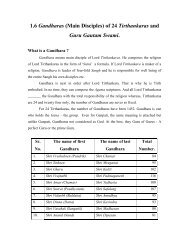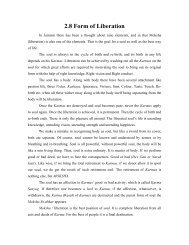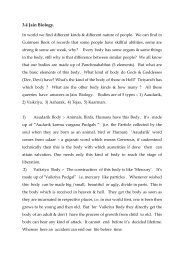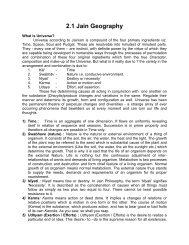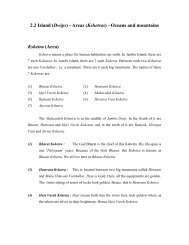âæ¢ ç¸ï¼¯ï¼ è£æ½® J - Jainism, Jain Religion - colleges
âæ¢ ç¸ï¼¯ï¼ è£æ½® J - Jainism, Jain Religion - colleges
âæ¢ ç¸ï¼¯ï¼ è£æ½® J - Jainism, Jain Religion - colleges
You also want an ePaper? Increase the reach of your titles
YUMPU automatically turns print PDFs into web optimized ePapers that Google loves.
Great scholars like Vyakta and Arya Sudharma also came and removing their doubts became Mahavir’s disciples along with<br />
their 500 followers each. Similarly, Mauryaputra and Akampita with their 350 disciples each; Achalbhrata, Metarya, and<br />
Prabhas each with 300 disciples got initiated into Mahavir’s order.<br />
Thus, eleven great scholars were inducted with their 4400 disciples into Mahavir’s order during his first discourse.<br />
Establishment of the Ford<br />
The eleventh day of the bright half of the month of Vaishakh is considered to be the date of historical glory of the <strong>Jain</strong> tradition.<br />
On the tenth of the same month Bhagavan Mahavir attained omniscience, so the day is important as the occasion of his<br />
personal triumph. But from the view point of establishing the religious organization (Tirth/Ford) the eleventh is the most<br />
important day. It was on this day that the eleven great Brahman scholars rid themselves of their ego of superiority by birth and<br />
the misconceptions, and were initiated into the Shraman tradition based on equanimity and Ahimsa. They became the chief<br />
disciples or Ganadhars of Mahavir. In <strong>Jain</strong> tradition Ganadhar is the most exalted spiritual person after the Tirthankar.<br />
„±üü ¿¢¢Ý¢² ½±¼é J<br />
Thousands of other men and women were also converted many of who became ascetics and other took the vows for laity.<br />
Princess Chandanbala, who had fulfilled the complex resolve of Bhagavan Mahavir, was also waiting for this auspicious day.<br />
As soon as she got the news that Mahavir had attained omniscience, she was overjoyed. She reached the divine pavilion by<br />
fastest available means. Many worthy pavilions also accompanied her. After listening too the discourse she became the first<br />
woman ascetic disciple of Mahavir.<br />
Shankh and Shatak with many other rich and prominent citizens joined Mahavir’s order as lay followers. Sulasa and many<br />
other women also joined the religious family. Thus, the land of Mahasen jungle in Madhyam Pava and the eleventh day of the<br />
bright half of the month of Vaishakh became the blessed land and he blessed day respectively.<br />
The Achievements<br />
The twelve-year period of spiritual practices of Bhagavan Mahavir was the basis of his personal achievement of omniscience<br />
and the status of Arihant/Tirthankar. After his enlightenment the remaining thirty years of his life were devoted to the welfare<br />
of the living world. During this period he revolutionized human thought and shattered many long established misconceptions<br />
and curses of traditional dogmas. His deeds and achievements in the fields of human welfare and upliftment as well as his<br />
contribution to the storehouse of human knowledge may be briefly summed up as—<br />
1. He opposed the wanton human and animal sacrifice and misleading rituals in the name of religious Yajnas for benefits in<br />
the next life. As a more humane and rational alternative he showed the path of Ahimsa.<br />
2. He broke the established tradition of depriving women in general and men of lower castes from the formal study of<br />
scriptures and indulging<br />
jainuniversity.org<br />
many religious activities. He was bold enough to initiate people from this section of society into<br />
his religious order. He provided equal rights and opportunities to al for study and practice of religion. He successfully<br />
rooted out the caste system in his area of influence at social and spiritual level.<br />
3. Under his influence the established norms of social status based on caste, wealth, power and grandeur were shattered<br />
and new norms of social status based on virtues and moral and ethical values were established.<br />
4. He used Ardha-Magadhi, the lingua franca of that period for his discourses. Giving importance to folk culture and<br />
language of the masses over Sanskrit, the language of scholarly few and the upper class, he preached in eloquent and<br />
attractive style.<br />
5. For the ascetics of his school pursuing the path of detachment with the help of disciple, penance chanting and meditation,<br />
he also prescribed regular indulgence in activities of social welfare. His order included people from all sections of the<br />
society-Indrabhuti Gautam and many others from the Brahmin caste; Shalibhadra, Dhanna and many others from the<br />
Vaishya caste; Megh Kumar, Nandisen, etc. from the Kshatriya caste; and Maitarya, Arjunmali, etc. from the Shudra<br />
caste. Among women prominent in his order Chandanbala, Mrigavati, Kali, etc. were from ruling families and Subhadra,<br />
Revati, etc. were from the merchant class.<br />
6. The Shravakas (householders) in his organization included people from all walks of life. Udayi, Shrenik, Ajatshatru, etc.<br />
were kings; Anand was a farmer; Saddalputra was a potter; and Sulas was a butcher.<br />
7. The religious organization of Mahavir was founded on virtues like detachment; equanimity, knowledge and disciple.<br />
8. The original contributions of Mahavir were Ahimsa as the basis of code of conduct and relativity of thought (Anekant) as<br />
the basis of spiritual purity and equanimity.<br />
9. As Mahavir had millions, of admirers and followers, he also had opponents like Gaushalak and decanters like Jamali. For<br />
5 to 6 years Jamali moved with Mahavir as his disciple. But later, driven by ambition and lust for popularity he became<br />
Mahavir’s opponent. He projected himself as omniscient and Tirthankar. The feeling of envy burning within him made<br />
him attach Mahavir and try to burn him. But the great pacifying powers of a true Tirthankar defeated him. Compassionate<br />
Mahavir still forgave him and advised to work for purity of the soul.<br />
The Liberation<br />
At the request of king Hastipal Mahavir spent his last monsoon-stay at Pavapuri (Apapapuri) at the age of 72 years. When<br />
Amar Muni - Tirthankar Charitra - Surana # 45<br />
www.jainuniversity.org






